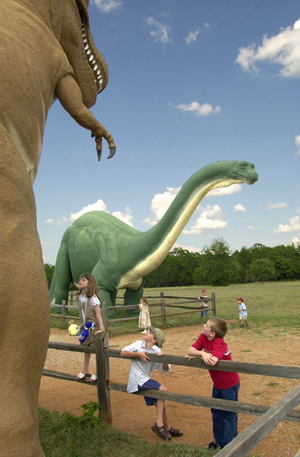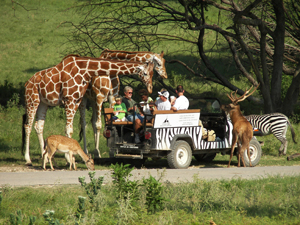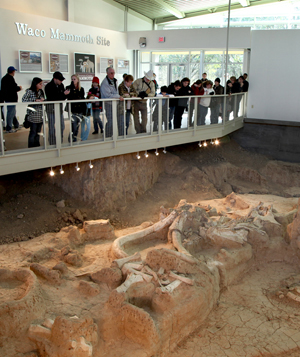Looking for something to do this spring break but want to avoid the crowds at some of the more popular
destinations? Consider a visit to one of the many interesting and historical sites in the Brazos River basin.
From following dinosaur tracks long set in a rock stream bed to exploring a maze of hike and bike
trails through one of the largest urban parks in the state, there are lots of inexpensive ways to have fun – without the headaches and lines found at the
typical spring break areas.
UPPER BRAZOS BASIN
Dinosaur Valley State Park

About 113 million years ago, the Gulf of Mexico came up to the area around what is now Glen Rose, Texas in Somervell County. Dinosaurs would travel
through the area in search of food, leaving their footprints deep in the mud of the tidal flats. Over eons, sediment covered and protected the prints as the mud hardened to stone.
Today these prints can be seen in the bed of the Paluxy River, a Brazos tributary. Dinosaur Valley contains some of the
best-preserved dinosaur tracks in the world.
The footprints likely are from creatures including the paluxysaurus, which weighed up to 45 tons and is the Texas state dinosaur.
Other prints are probably by the acrocanthosaurus, a meat-eating predator, and the plant-eating iguanodon.
The tracks can be seen in several locations in the 1,523-acre park, which encompasses a scenic bend in the river.
One especially popular viewing site is along a rock ledge next to the Blue Hole, an old-time swimming hole.
The park includes 12 miles of hike and bike trails, an equestrian riding area, a day-use picnic area, group picnic
pavilion with picnic tables and fireplace, and an outdoor amphitheater. The visitors’ center includes a store where you can buy souvenirs of your trip.
Dinosaur Valley also offers numerous campsites with electricity, water and nearby restrooms.
For the more adventurous, the park has primitive camp sites that require a 1 to 2-mile hike.
For more information, including fees and hours, call the park at (254) 897-4588 or go to the park’s Web site,
here.

Fossil Rim Wildlife Center
A few miles south of Dinosaur Valley, this privately run wildlife conservation park features a variety of
exotic animals you can view as you drive the park’s 9½-mile route.
Traveling among the more than 1,100 animals from 50 species roaming the 1,800-acre site you might see a giraffe,
rhinoceros, ostrich, cheetah, red wolf or many others. Visitors can also pay a little extra and get a bag of food to feed some of the animals.
The park, operated by the non-profit Fossil Rim Foundation, opened in 1986 to research, breed and manage endangered species.
Fossil Rim offers guided and “behind the scenes” tours and hosts school and other groups. The park also has a store
and restaurant as well as a lodge and more rustic safari campsites for overnight stays.
Visitors with children may be pleased to note Fossil Rim also has a Children’s Animal Center, where they can
watch and pet pygmy goats, reptiles and other critters. The park also offers a half-mile walking trail that could be a prime location to spy Texas wildflowers that bloom in the spring.
For more information, call (254) 897-2960 or visit the Fossil Rim Web site
here.
CENTRAL BASIN
Cameron Park
This scenic treasure covers 416 acres of hilly land along the Brazos and Bosque rivers on the northwest side of
the City of Waco. The park is loved by locals looking for a quick break from city life as well as mountain biking enthusiasts who find its winding trails a challenge.
Once the home to Huaco Indians, the land was later owned by Waco resident William Cameron. He made his fortune in the
lumber business before giving the property to the city of Waco in 1910 for the “perpetual enjoyment of the people.”
Today, Cameron Park is one of the largest urban parks in Texas. Visitors are often drawn by its beautiful and serene
settings, though it’s not far from downtown.
The park’s limestone cliffs, with names like Lover’s Leap, tower more than 100 feet above the rivers and offer a
breathtaking view of the surrounding countryside. Farther east, you can stroll through a grove of old pecan trees along the river in an area known as “Pecan Bottoms.”
This area features a free water spray park, courtesy of the city.
Cameron Park Zoo is located nearby. The zoo features animals ranging from orangutans to lions to lemurs.
One of the zoo’s highlights is Brazos River Country, a re-creation of the Brazos River’s regions, from the plains on the Caprock in West Texas to the mouth of the river at the Gulf of Mexico.
Cameron Park’s most popular area is its trail system. The more than 20 miles of twisting, climbing trails through the park’s
dense wooded areas are well known among hikers and cyclists. The trails, with names like “Sidewinder” and “Act of Faith” have been listed among the 50 best in the country by Bike Magazine.
For more information about the zoo, call (254) 750-8400 or go to the zoo’s Web site, here.

The Waco Mammoth Site
Just up the Bosque River from Cameron Park, this is the spot where in 1978 two men searching for arrowheads and
fossils found a large bone sticking out of a ravine. Scientists identified the bone as belonging to a Columbian mammoth, a species of elephant that has been extinct
for thousands of years.
In the years since, workers have excavated 22 mammoth fossils from what is the only recorded discovery of a
nursery herd of Pleistocene mammoths. Also found in this spot was an extinct camel, part of a saber-tooth cat and another unidentified animal. While the cause of
the animals’ death remains a mystery, at least some of them are suspected to have died in a flood.
The site remained closed to the public until 2009, when a public park was opened on the 100-acre property.
The park’s centerpiece is its dig shelter, which allows visitors to view the mammoth fossils from walkways suspended above, inside a closed, lighted building.
The park also features a walking trail and welcome center with a gift shop.
The site continues to evolve, and officials hope to expand it in the coming years.
In 2015, a Presidential Executive Order designated the Waco Mammoth site a national monument making the site the 408th National Park Service site and the 14th in Texas.
For more information about the site, call (254) 750-7946 or visit the Web site, here.
LOWER BASIN
Surfside Beach and Quintana
If you are looking to take in the sea and sand in a place steeped in Texas history, few places rival the
communities of Surfside Beach and Quintana at the mouth of the Brazos River.
The Gulf shore burgs sit on islands that frame each shore of the river. Those who enjoy the warm Gulf water and
the many activities the towns have to offer might not realize the area has played an important role since long before it drew tourists.
In 1821, the father of Texas, Stephen F. Austin, brought a group of colonists to the area. Austin went on to set
up the town of Quintana at the behest of Mexican officials.
The area also saw some of the first fighting between Texans and Mexicans in 1832, when Texans attempted to bring
cannon through the area by boat.
The commander of the Mexican Fort Velasco, also located in this area, unsuccessfully challenged the Texans,
before surrendering. In 1836, the war with Mexico formally ended, and independence began, with the signing of treaties at Velasco.
During the Civil War, the Confederacy set up a fort at Quintana, which came under shelling by the Union Navy.
The area again saw artillery installed during World War II. Guns were placed in what is now the county park, in an effort to protect important chemical plants upriver.
Though six hurricanes have struck the area, including the devastating 1900 hurricane and 2008’s Hurricane Ike, the area has
long drawn people wanting to relax in its beauty.
According to the Handbook of Texas History Online, during the antebellum period, plantation families prized the area as a
vacation spot, and a row of fine homes lined the beach.
These days, homes still sit along the beach, and one can find plenty of things to do. Besides visiting the historic sites,
surfing, fishing and even bird watching is popular in the area. The communities also offer several shops and restaurants as well as hotels and rental beach houses.
For more information about Quintana, go here.
For Surfside Beach, click
here.